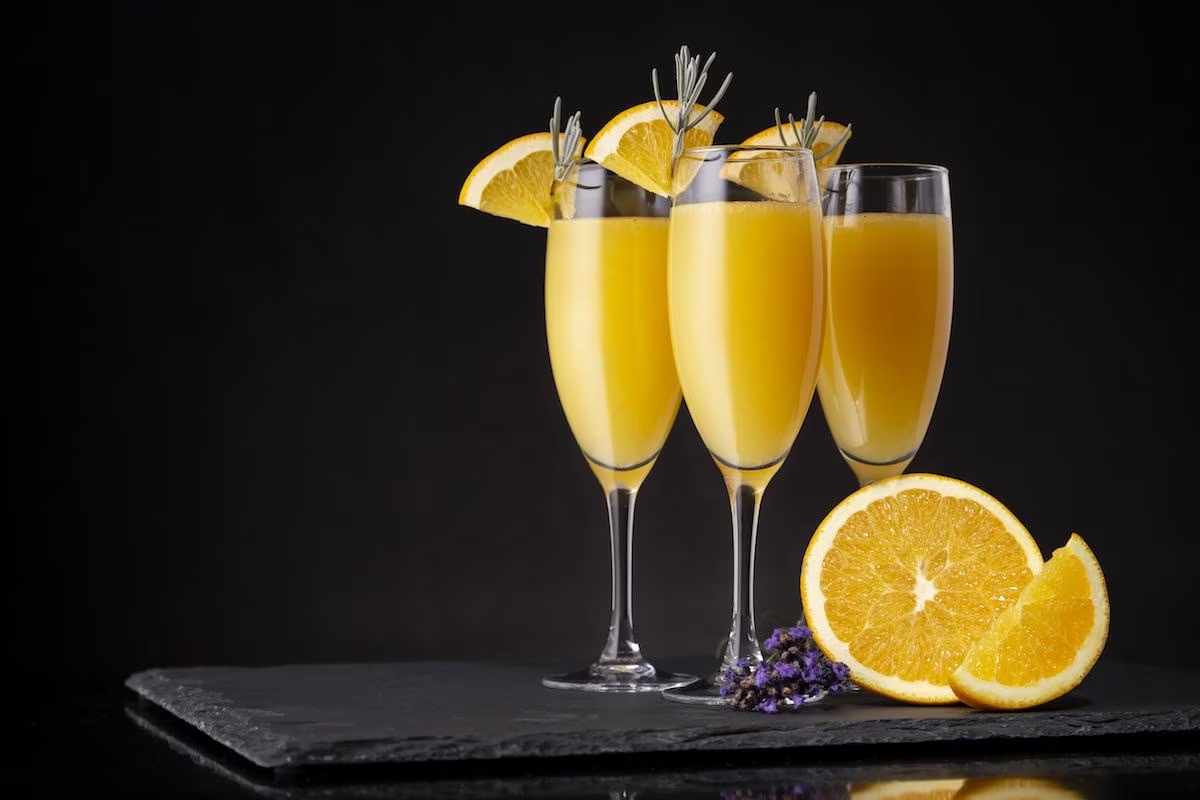
With its effervescent charm and vibrant citrus notes, the Mimosa has captivated brunch enthusiasts and cocktail aficionados alike for nearly a century. Originating in the elegant ambiance of the Ritz Hotel in Paris, this iconic libation has evolved into a beloved staple of leisurely breakfast gatherings, celebratory occasions, and warm summer afternoons. From its humble beginnings as a Prohibition-era concoction to its global appeal and endless variations, the Mimosa embodies the spirit of conviviality and indulgence. Join us on a journey through the sparkling world of the Mimosa as we explore its history, variations, and enduring allure.
Birth of a Brunch Classic: The Mimosa’s origin story traces back to the glamorous ambiance of the Ritz Hotel in Paris around 1925. While its exact debut remains a matter of speculation, it’s widely believed that this iconic cocktail emerged during this era, adding a touch of effervescence to the brunch scene. The allure of the Mimosa lies not only in its refreshing taste but also in the romanticized notion of sipping champagne-infused concoctions amidst Parisian sophistication.
Champagne Inspiration: The Mimosa’s name and effervescent nature are thought to have been inspired by the delicate mimosa flower, renowned for its champagne-colored blossoms. This botanical connection adds a whimsical layer to the cocktail’s identity, evoking images of blooming gardens and refined elegance. The mimosa flower’s association with celebration and beauty further enhances the allure of this beloved brunch beverage.
Early Prohibition Twist: During the Prohibition era in the United States (1920s-1933), inventive mixologists sought ways to mask the flavors of lower-quality spirits. The Mimosa, with its harmonious blend of champagne and fruit juice, emerged as a delightful solution. By combining the effervescence of champagne with the vibrant flavors of citrus, bartenders crafted a drink that not only masked the taste of inferior sparkling wines but also offered a refreshing respite from the dry era of Prohibition.
Simple is Best: The classic Mimosa recipe epitomizes simplicity, requiring only two ingredients in equal parts: chilled champagne or sparkling wine and chilled orange juice. This straightforward yet elegant concoction embodies the essence of effortless sophistication, making it a perennial favorite for brunch enthusiasts and cocktail aficionados alike. The balanced ratio of champagne to orange juice ensures a harmonious marriage of flavors, resulting in a drink that is both light and indulgent.
Flute Power: Presentation is key when it comes to serving Mimosas, and the choice of glassware plays a crucial role in enhancing the drinking experience. The traditional Mimosa is elegantly served in a champagne flute, allowing its effervescence to sparkle against the slender silhouette of the glass. This visually stunning presentation not only accentuates the cocktail’s vibrant color but also preserves its delightful bubbles, creating a sensory feast for the eyes and palate alike.
Fruity Fiesta: While orange juice is the classic choice for Mimosa aficionados, the versatility of this cocktail extends far beyond its traditional boundaries. From the tangy zest of grapefruit to the luscious sweetness of peach and mango, a myriad of fruit juices can be used to infuse the Mimosa with a tantalizing array of flavors. This playful experimentation adds a delightful twist to the cocktail, inviting enthusiasts to explore new and exotic combinations that tantalize the taste buds and elevate the drinking experience to new heights.
Sparkling Celebration: Mimosas have become synonymous with celebratory occasions, from leisurely brunches and baby showers to festive breakfast gatherings. The light and refreshing taste of this effervescent cocktail makes it the perfect companion for joyous festivities, effortlessly setting the mood for convivial conversation and shared laughter. Whether sipped under the morning sun or toasted under the twinkling stars, Mimosas embody the spirit of celebration and camaraderie, uniting friends and family in a sparkling symphony of flavors.
Royal Connection: Rumored to be a favorite of Queen Elizabeth II, the Mimosa holds a regal allure that transcends its humble origins. The notion of royalty indulging in this bubbly concoction lends an air of sophistication and refinement to the cocktail, elevating it to a status befitting kings and queens. While its royal association may remain speculative, the allure of sipping on a Mimosa fit for a monarch adds an extra layer of intrigue to this beloved brunch classic.
National Mimosa Day: May 15th marks a special occasion for Mimosa enthusiasts worldwide, as it is dedicated to celebrating the bubbly brilliance of this iconic cocktail. This designated day serves as a reminder to raise a glass in honor of the Mimosa’s enduring legacy, paying homage to its role as a staple of brunch culture and a symbol of conviviality. Whether enjoyed at home or savored in the company of friends at a favorite brunch spot, National Mimosa Day offers a delightful excuse to indulge in this effervescent libation and toast to life’s simple pleasures.
Mimosa vs. Buck’s Fizz: While the Mimosa and the Buck’s Fizz share a similar lineage, subtle differences distinguish these two beloved brunch cocktails. The Buck’s Fizz, a British cousin of the Mimosa, features a slightly lower ratio of orange juice to champagne, with one part juice to two parts champagne. This nuanced variation results in a drink that is slightly drier and more champagne-forward, catering to palates that prefer a hint of citrus without overwhelming the delicate effervescence of the champagne.
Fruity Mimosa Records: In 2014, a festival in Texas set the world record for the most flavors of Mimosas offered at a single event, boasting an impressive lineup of 27 variations. This feat of mixology showcased the versatility of the Mimosa, highlighting the endless possibilities for creative experimentation with different fruit juices and flavor combinations.
Boozy Brunch Boom: A 2019 study by SevenRooms, a restaurant reservation platform, revealed that Mimosas were the most ordered brunch cocktail in the United States, comprising 22% of all brunch drink orders. This data underscores the enduring popularity of Mimosas as a quintessential brunch beverage, beloved for their refreshing taste and celebratory allure.
Global Appeal: Mimosas have transcended cultural boundaries to become a beloved libation worldwide, with variations incorporating local fruits and flavors in regions as diverse as South America and Southeast Asia. This global appeal speaks to the universal joy of indulging in a light and effervescent cocktail that embodies the spirit of leisure and relaxation.
Non-alcoholic Alternative: For those seeking a refreshing alcohol-free option, Virgin Mimosas offer a delightful alternative made with sparkling water or club soda instead of champagne. This alcohol-free twist retains the vibrant flavors and fizzy effervescence of the classic Mimosa, making it a popular choice for teetotalers and designated drivers alike.
Mimosa Calories: A classic Mimosa with standard pours typically ranges from 120 to 150 calories, depending on the juice and champagne used. This moderate calorie count makes Mimosas a relatively light and guilt-free indulgence, perfect for those looking to enjoy a refreshing cocktail without overindulging.
Fizzy Facts: The average bottle of champagne contains approximately 49 million bubbles, creating a mesmerizing display of effervescence with each pour. This fizzy phenomenon adds a playful element to the Mimosa experience, tickling the palate with tiny bubbles that dance across the tongue in a symphony of effervescence.
Mimosa Garnishes: A sprig of fresh mint, a juicy raspberry, or a slice of zesty orange can elevate the presentation of a Mimosa, adding a touch of elegance and flavor to this beloved brunch libation. These simple yet stylish garnishes enhance the visual appeal of the cocktail, transforming it into a work of art that tantalizes the senses.
Orange Powerhouse: A 4-ounce serving of orange juice provides nearly the entire daily recommended intake of Vitamin C, making it a nutritional powerhouse that complements the indulgent nature of the Mimosa. This citrusy boost adds a refreshing burst of flavor to the cocktail, while also offering a dose of essential nutrients to invigorate the body and mind.
Champagne vs. Sparkling Wine: While true champagne originates from the Champagne region of France, sparkling wine can be produced anywhere in the world using different methods. This distinction underscores the importance of terroir and production techniques in shaping the flavor profile of sparkling wines, with each region imparting its unique characteristics to the final product.
Pricey Fizz: While a bottle of vintage champagne can command prices in the thousands of dollars, prosecco, a popular sparkling wine for Mimosas, typically falls in the more affordable $10 to $30 range. This disparity in price reflects the prestige and rarity of vintage champagnes, which are prized for their complexity and aging potential, while also highlighting the accessibility of prosecco as a versatile and budget-friendly alternative for everyday indulgence.
Mimosa Mishap: In 2014, a New York restaurant made headlines when a waiter accidentally served drain cleaner instead of orange juice for Mimosas. Fortunately, no one was harmed in the incident, but it serves as a cautionary tale for the importance of proper ingredient labeling and handling in food and beverage service establishments.
Sustainable Sipping: As environmental awareness grows, there is increasing emphasis on sustainability in the production of champagne and sparkling wines. By opting for products produced using sustainable practices, consumers can minimize their environmental impact and support wineries that prioritize eco-friendly initiatives such as organic farming, water conservation, and energy efficiency.
Fruity Freeze: Frozen Mimosas, blended with ice and fruit, have become a popular variation of the classic cocktail, particularly during summertime or poolside gatherings. This frosty twist adds a refreshing chill to the Mimosa, transforming it into a slushy delight that cools and invigorates on hot summer days.
Mimosa Mocktails: Creative mocktails offer a non-alcoholic alternative to Mimosas, mimicking the look and taste of the classic cocktail with colorful fruit juices, sparkling water, and grenadine for a layered effect. These alcohol-free concoctions cater to individuals who prefer to abstain from alcohol or those looking for lighter alternatives without compromising on flavor or presentation.
Beyond Brunch: While Mimosas are traditionally associated with brunch, they can be enjoyed anytime, serving as a delightful choice for a light and celebratory drink on warm afternoons or festive evenings. This versatility underscores the enduring appeal of the Mimosa as a beloved libation that transcends mealtime boundaries, inviting enthusiasts to indulge in its effervescent charm whenever the mood strikes.
5 Frequently Asked Questions about Mimosa cocktail:
What’s the difference between a Mimosa and a Buck’s Fizz?
These brunch favorites are very similar, but with a key ratio difference. A classic Mimosa uses equal parts champagne or sparkling wine (2 oz) and orange juice (2 oz) for a balanced bubbly beverage. The Buck’s Fizz, on the other hand, leans slightly sweeter with a higher champagne to juice ratio (typically 1 part juice to 2 parts champagne). This results in a slightly less intense orange flavor compared to the Mimosa.
Can I use any type of juice in my Mimosa?
Absolutely! While orange juice reigns supreme in the Mimosa world, feel free to experiment with other flavors. Grapefruit juice offers a tart and refreshing twist, while peach or mango juice adds a touch of sweetness and tropical flair. For a more exotic option, pomegranate juice lends a vibrant color and a unique flavor profile.
What’s the best type of champagne or sparkling wine for Mimosas?
Dry sparkling wines like Brut champagne or Prosecco pair well with the citrusy flavors of orange juice. Since Mimosas are known for their light and refreshing taste, avoid using overly sweet sparkling wines like Moscato d’Asti, which might overpower the orange juice. Ultimately, the best choice depends on your personal preference. For a more affordable option, Prosecco is a great choice, while champagne offers a touch of luxury.
Are there any non-alcoholic Mimosa options?
Certainly! Virgin Mimosas are a perfect alternative for those who prefer to avoid alcohol. Simply replace the champagne or sparkling wine with club soda or sparkling water. You can still add orange juice or your favorite fruit juice for a refreshing and flavorful drink. To enhance the visual appeal, consider adding a splash of grenadine for a layered effect, mimicking the classic Mimosa.
How many calories are in a Mimosa?
The calorie content of a Mimosa depends on the type of juice and champagne or sparkling wine used. A classic Mimosa with standard pours (2 oz each of champagne and orange juice) typically ranges from 120 to 150 calories. Using freshly squeezed orange juice can add a few more calories compared to store-bought varieties. If you’re watching your calorie intake, consider using a smaller champagne flute or opting for a slightly larger ratio of sparkling water in your Virgin Mimosa.









